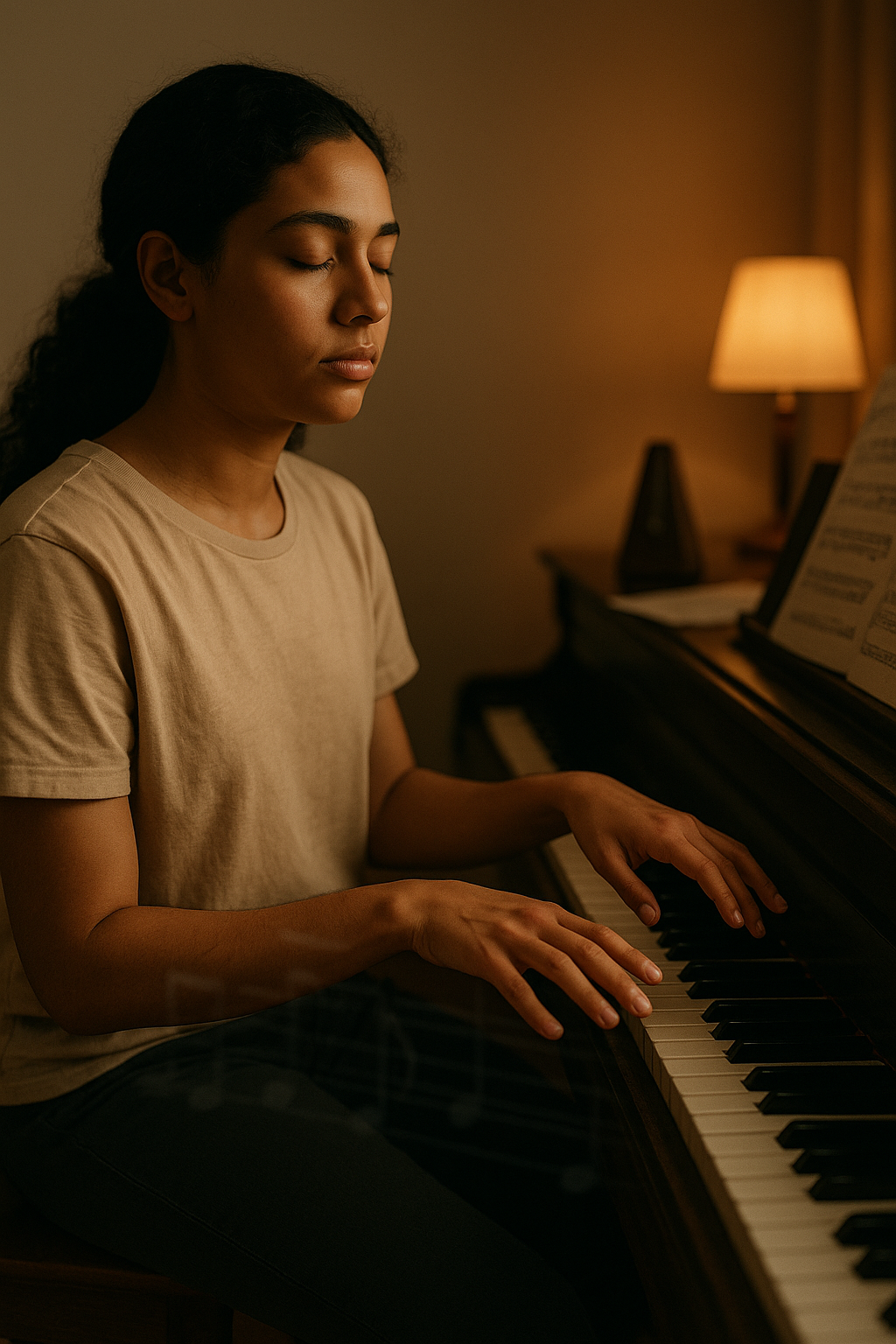When people think about practicing music, the image that comes to mind is usually sitting at a piano, strumming a guitar, or singing scales out loud. But practice doesn’t always have to involve physically playing your instrument. In fact, some of the world’s greatest musicians have relied heavily on a powerful yet often overlooked technique: mental practice.
Mental practice means rehearsing music in your mind rather than physically performing it. At first, it might sound strange—how can imagining a piece of music improve your skills? But research in psychology and neuroscience shows that mental practice can strengthen memory, improve performance, and even activate the same brain areas as physical practice. For beginners, understanding and applying mental practice can accelerate progress and make learning more efficient.
What Is Mental Practice?
Mental practice involves imagining yourself playing music, hearing the notes in your head, and visualizing the physical movements required. Some musicians “see” their fingers on the piano keys, others “hear” the melody internally, and some combine both approaches. The key is focused, intentional visualization—not daydreaming, but mentally rehearsing with detail and concentration.
Why Mental Practice Works
Activates the Brain Like Physical Practice
Studies using brain imaging show that imagining playing an instrument activates many of the same neural circuits as actually doing it. This mental rehearsal strengthens pathways needed for performance.
Strengthens Memory
Visualizing notes, rhythms, and fingerings builds stronger memory connections, reducing reliance on sheet music.
Improves Focus
Mental practice requires concentration. Over time, this strengthens your ability to focus during real practice and performance.
Reduces Fatigue
You can practice mentally anywhere—on the bus, before bed, or while resting—without tiring your muscles.
Builds Confidence
When you rehearse mentally, you picture success, which boosts confidence and reduces performance anxiety.
How Mental Practice Has Been Used in History
- Pianist Glenn Gould was known for his ability to practice entire pieces in his head, achieving extraordinary precision.
- Violinist Yehudi Menuhin used mental rehearsal to prepare before performances.
- Athletes also use visualization extensively, showing its effectiveness beyond music.
These examples prove that mental practice is not just theory—it works.
Practical Ways to Use Mental Practice
1. Visualize While Looking at the Score
Sit with your sheet music and imagine playing it. See the notes, hear the rhythms, and feel your fingers moving.
2. Break It Into Sections
Just like physical practice, focus on small sections. Mentally repeat a measure until you can hear it clearly in your head.
3. Combine With Physical Practice
Alternate between mental and physical practice. For example, play a passage once, then visualize it once.
4. Use Silent Instruments
Pianists can press keys without sound, imagining the tones. Guitarists can finger chords without strumming. This bridges mental and physical rehearsal.
5. Rehearse Performances
Imagine walking onto stage, playing confidently, and handling mistakes gracefully. This prepares you mentally for real-life performance pressure.
Exercises to Develop Mental Practice Skills
- Silent Score Reading
Read a short piece silently, then try to hear every note internally. - Hand Visualization
Without touching your instrument, imagine your hands or fingers moving correctly through a passage. - Rhythm Tapping
Tap rhythms on a table while hearing the melody in your head. - Daily Visualization Routine
Spend 5–10 minutes before sleep mentally rehearsing your current piece. - Error Correction
When you notice a mistake in practice, visualize the correct version several times before trying again physically.
Overcoming Challenges in Mental Practice
- Distractions: It’s easy for your mind to wander. Start small—just 30 seconds at a time.
- Lack of Detail: Try to include as many senses as possible—what the keys feel like, how the bow moves, how your breath flows.
- Doubts About Effectiveness: Remember that many professional musicians rely on this technique. Consistency is key.
The Psychological Benefits of Mental Practice
Reduces Anxiety
By mentally rehearsing performance scenarios, you prepare yourself emotionally and reduce nerves.
Builds Positivity
Visualization helps you picture success rather than focusing on fear of mistakes.
Encourages Patience
Mental practice teaches you that improvement is not only physical—it’s also mental and emotional.
How Teachers Can Encourage Mental Practice
Teachers can guide students by:
- Assigning short mental practice sessions alongside regular practice.
- Asking students to describe what they “heard” or “saw” in their minds.
- Encouraging mental rehearsal before tests or recitals.
This approach helps beginners form the habit early.
Long-Term Benefits of Mental Practice
- Faster memorization of pieces.
- Better accuracy in performance.
- Greater resilience under pressure.
- More efficient use of practice time.
- Stronger overall musicianship through deeper mental engagement.
Final Thoughts: Practicing Without Touching Your Instrument
Mental practice is like having a secret rehearsal room in your mind. It doesn’t replace physical practice, but it complements it in powerful ways. By combining both approaches, you can progress faster, play more confidently, and reduce stress along the way.
The next time you don’t have your instrument, don’t think of it as wasted time. Close your eyes, imagine the notes, and rehearse mentally. With discipline, you’ll discover that your mind is one of the most powerful instruments you possess.
